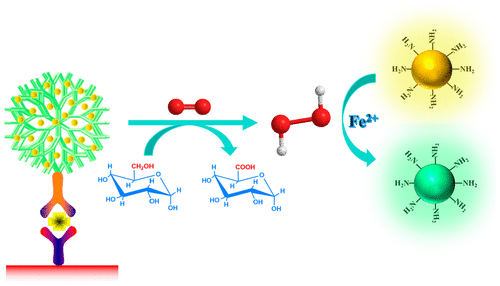当前位置:
X-MOL 学术
›
ACS Appl. Mater. Interfaces
›
论文详情
Our official English website, www.x-mol.net, welcomes your feedback! (Note: you will need to create a separate account there.)
Emission Wavelength Switchable Carbon Dots Combined with Biomimetic Inorganic Nanozymes for a Two-Photon Fluorescence Immunoassay.
ACS Applied Materials & Interfaces ( IF 9.5 ) Pub Date : 2020-06-12 , DOI: 10.1021/acsami.0c06240 Yuanjin Zhan 1 , Shuangting Yang 1, 2 , Fang Luo 3 , Longhua Guo 2 , Yanbo Zeng 2 , Bin Qiu 1 , Zhenyu Lin 1
ACS Applied Materials & Interfaces ( IF 9.5 ) Pub Date : 2020-06-12 , DOI: 10.1021/acsami.0c06240 Yuanjin Zhan 1 , Shuangting Yang 1, 2 , Fang Luo 3 , Longhua Guo 2 , Yanbo Zeng 2 , Bin Qiu 1 , Zhenyu Lin 1
Affiliation

|
In this work, o-phenylenediamine is utilized as a precursor to synthesize the fluorescent emission wavelength switchable carbon dots (o-CDs). Our investigation reveals that ferrous ions (Fe2+) can effectively induce fluorescence quenching of o-CDs by chelation and aggregation. After the addition of hydrogen peroxide (H2O2), the fluorescence of o-CDs recovers and the fluorescent color changes from yellow to green. As far as we know, o-CDs are the first reported CDs with switchable fluorescence emission wavelength. In order to fabricate an enzyme-free immunosensor, an amino-functionalized dendritic mesoporous silica nanoparticle (DMSN)–gold nanoparticle (Au NP) nanostructure was fabricated as a glucose oxidase mimetic nanoenzyme by in situ coating of the Au NPs on the surface of the DMSNs. Then, the functionalized DMSN-Au NPs were modified on the detection antibody and hydrolyzed with glucose to produce H2O2. This immune induced recognition strategy combines with the o-CDs+Fe2+ signal generation system to achieve specific and sensitive detection of the target. The replacement of glucose oxidase by DMSN-Au NPs not only reduces the cost but also provides significantly amplified signals due to DMSNs haing a high specific surface area. We show the detection of carcinoembryonic antigen (CEA) as an example target to evaluate the analytical figure of merits of the proposed strategy. Under the optimal conditions, two-photon-based o-CDs displayed excellent performances for CEA and the limit of detection as low as 74.5 pg/mL with a linear range from 0.1 to 80 ng/mL. The proposed fluorescent immunosensor provides an optional and potential scheme for low cost, high sensitivity, and versatile discovery of clinical biomarkers.
中文翻译:

发射波长可切换碳点结合仿生无机纳米酶用于双光子荧光免疫测定。
在这项工作中,邻苯二胺被用作合成荧光发射波长可切换碳点(o -CDs)的前体。我们的研究表明,亚铁离子(Fe 2+)可通过螯合和聚集有效诱导o -CD的荧光猝灭。加入过氧化氢(H 2 O 2)后,o -CD的荧光恢复,荧光颜色从黄色变为绿色。据我们所知,Ô-CD是最早报道的具有可切换荧光发射波长的CD。为了制造无酶免疫传感器,通过在表面上原位包被金纳米颗粒,将氨基官能化的树枝状介孔二氧化硅纳米颗粒(DMSN)-金纳米颗粒(Au NP)纳米结构制成葡萄糖氧化酶模拟纳米酶。 DMSN。然后,在检测抗体上修饰功能化的DMSN-Au NP,并用葡萄糖水解产生H 2 O 2。这种免疫诱导的识别策略与o -CDs + Fe 2+信号生成系统实现对目标的特异性和灵敏检测。用DMSN-Au NP代替葡萄糖氧化酶不仅降低了成本,而且由于DMSN具有高的比表面积而提供了明显放大的信号。我们展示了检测癌胚抗原(CEA)作为示例目标,以评估所提出策略的优缺点的分析数字。在最佳条件下,基于双光子的o - CD表现出出色的CEA性能,检出限低至74.5 pg / mL,线性范围为0.1至80 ng / mL。所提出的荧光免疫传感器为低成本,高灵敏度和临床生物标记物的广泛发现提供了一种可选的潜在方案。
更新日期:2020-07-08
中文翻译:

发射波长可切换碳点结合仿生无机纳米酶用于双光子荧光免疫测定。
在这项工作中,邻苯二胺被用作合成荧光发射波长可切换碳点(o -CDs)的前体。我们的研究表明,亚铁离子(Fe 2+)可通过螯合和聚集有效诱导o -CD的荧光猝灭。加入过氧化氢(H 2 O 2)后,o -CD的荧光恢复,荧光颜色从黄色变为绿色。据我们所知,Ô-CD是最早报道的具有可切换荧光发射波长的CD。为了制造无酶免疫传感器,通过在表面上原位包被金纳米颗粒,将氨基官能化的树枝状介孔二氧化硅纳米颗粒(DMSN)-金纳米颗粒(Au NP)纳米结构制成葡萄糖氧化酶模拟纳米酶。 DMSN。然后,在检测抗体上修饰功能化的DMSN-Au NP,并用葡萄糖水解产生H 2 O 2。这种免疫诱导的识别策略与o -CDs + Fe 2+信号生成系统实现对目标的特异性和灵敏检测。用DMSN-Au NP代替葡萄糖氧化酶不仅降低了成本,而且由于DMSN具有高的比表面积而提供了明显放大的信号。我们展示了检测癌胚抗原(CEA)作为示例目标,以评估所提出策略的优缺点的分析数字。在最佳条件下,基于双光子的o - CD表现出出色的CEA性能,检出限低至74.5 pg / mL,线性范围为0.1至80 ng / mL。所提出的荧光免疫传感器为低成本,高灵敏度和临床生物标记物的广泛发现提供了一种可选的潜在方案。



























 京公网安备 11010802027423号
京公网安备 11010802027423号